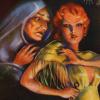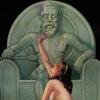Fantasy Sub-Genres: A Wide World to Discover
High, low, light… Myriad sub-genres define fantasy. Whether they are faraway, enchanted stories or darkly apocalyptic tales, find out more about this abundant genre’s hidden treasures.
A Profusion of Sub-Genres
Fantasy’s scope is extremely broad, covering all sorts of speculative fiction, particularly in English, where the term fantasy includes what in French is called the fantastique (tales that tend to have less magic and more mystery). Behind the most-familiar markers (elves, dragons, kingdoms and more), a profusion of sub-genres have developed over time. Sub-genres act both as useful benchmarks for aficionados looking for their favorites styles from one work to the next and as marketing tools to increase books’, films’ and games’ visibility. They are also the subject of often inflamed debate between fans, since their borders are intrinsically porous, and their definitions evolve over time and place. Genres are good for “putting a name” on a set of features, adapting to extant corpuses at any given time.
High and Low Fantasy
The first major distinction is between high and low fantasy, although the terms are not meant to be seen as a value judgment. The most iconic style of fantasy, the kind inspired by Tolkien’s imaginative worlds and noble quests, is known as high fantasy. Conversely, low fantasy is near to hand – as in Harry Potter (J. K. Rowling, 1997-2007), where the world of witchcraft and wizardry secretly coexists alongside the ordinary world of Muggles; and in the TV show Buffy the Vampire Slayer (Joss Whedon, 1997-2003), in which the high school in the fictional town of Sunnydale sits atop a “Hellmouth,” or gateway to demon realms.
Fantasy straddles the border with the fantastique, and the hybridity that is constitutive of fantasy is accentuated when conventions from other genres are introduced. When fantasy meets sentimental fiction, for instance, the result is “paranormal romance.” One example amongst many: the novels in Patricia Briggs’ Mercy Thompson series, since 2006.
Criteria for Sorting
Genre categories are many and competing. They often overlap, without being defined by the same criteria. They may refer to favored themes, as in urban fantasy. Set in large cities, the sub-genre generally implies a contemporary setting, similar to magical realism. Charles de Lint, with his Newford series (since 1990) is representative of that, as is Megan Lindholm – a.k.a. Robin Hobb – with her Wizard of the Pigeons (1986). There are also other, more surprising veins, such as “classical fantasy,” "or, more generally, “historical fantasy,” which revisits a specific time period, introducing magical or supernatural elements. French author Pierre Pevel did that for the Thirty Years War, in the Wielstadt trilogy (2001-2004), as the Canadian writer Guy Gavriel Kay did for the Byzantine empire, in The Sarantine Mosaic (1998-2000).
“Neo-Victorian fantasy” is a related sub-genre. Similar to steampunk, it reinvents the Victorian nineteenth century, filling it with alternative technologies (steam, ether, spirits and more); fabulous creatures (vampires, fairies, werewolves etc.) and intertextuality (Jules Verne, Charles Dickens, Oscar Wilde, Lewis Carroll et al.). The book series Timeless (Gail Carriger, 2009-2012), The Night Circus (Erin Morgenstern, 2011) and A Natural History of Dragons (Marie Brennan, 2013-2017) are all good examples of this.
Lastly, there is also the question of tone. “Light fantasy” tends to have a light, humorous tone. Author Terry Pratchett is the standard-bearer for that. At the opposite end of the spectrum, “dark fantasy” is close to horror. It covers a broad range of styles, from Stephen King’s Dark Tower series (1982-2012) – which expands on this master of the fantastique’s multiverse, tying together threads from many of his other novels – to Anne Bishop Black Jewels trilogy (1998-2010), which is filled with sensual witches and warlocks.
“Gritty fantasy,” a.k.a. “grimdark” is another sub-genre with bleak atmospheres. Glen Cook and his Black Company (1984-2000) can be seen as its precursors, and George R. R. Martin as its current standard bearer, alongside Joe Abercrombie and Mark Lawrence. Grimdark’s moral pessimism stands in sharp contrast with the the enchantment that is more typical of fantasy, and can be seen in the sub-genre’s morally ambiguous characters and in political stratagems and bloody violence tending to take precedence over magic.





